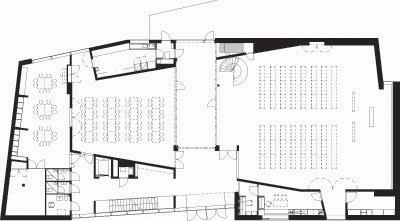Kuokkala Church
This winning proposal for the architecture competition held by the Jyväskylä parish is based on a compact, sculptural building that would contain all the functions of the church in a single recognizable shape.
With its brilliant combination of architectural presence and functional flexibility, the church becomes a landmark for the neighbourhood and a multi-functional facility centre for the local community.
Kuokkala Church, located in the Kuokkala suburb of Jyväskylä, is a compact, sculptural building gathering in a single shape all the different functions required by the Parish. The program is organized on three levels, with the offices opening directly to the market. On the main floor the church hall and the parish meeting hall can be combined into one large space with adjacent facilities for children and young people. Cladded in dark, slate tiles outside, the glue laminated timber vault system structure reveals its bright, naked nature in the interiors. The furnishing and interiors are all wooden, and can be moved and rearranged to accommodate a variety of activities.
The commission for the Kuokkala Church was won through an invited competition organized in 2006 asking to design a building which could become a focal point of the Kuokkala suburban area in Jyväskylä in order to foster the identity of the neighbourhood as a community of its own. The competition brief asked for offering different functions for the parish, such as the church hall, the parish centre and a community centre, and joining them in an innovative continuum by arranging them into a structure with a strong recognizable shape, creating a church that looks like a church.
For the competition, OOPEAA, operating under the name of Lassila Hirvilammi at the time, submitted a proposal entitled KIDE. It was a sculptural building containing all desired functions within one single recognizable shape, contemporary, yet rich in historical allusions. A dialogue of contrasts between the exterior and interior architecture is manifested in the material choices.
The roof and walls of the church are covered with overlapping tiles of Spanish slate, with wood and copper-covered entrance details that give the building a sense of warmth and scale. Other primary outer surfaces are clad in Finnish granite. Wood, mainly Finnish spruce, plays a central role in the interior spaces creating a warm atmosphere. Ceiling and floors are made of carefully selected local radially sawn spruce. The church ceiling is a combination of glue laminated timber framing with a wooden grid shell construction that unites the sacral spaces into one entity. The shape of the interior wooden grid, fixed on the primary structure, recalls Gothic cathedrals and relies on the knowledge of the masters of handcrafted building methods. The altar is made of limewood, which was used for carving the icons in traditional wooden churches. On the exterior the roof and walls are covered with overlapping dark slate tiles and the windows and entry areas are detailed in wood and copper.
The church and parish meeting halls can be combined into one large sacral space with adjoining youth facilities. A gallery between the halls houses the organ and the cantors offices. The sacral spaces are placed in the middle of the building and the service spaces (sacristy, storage spaces, kitchen, lobby) are located in a zone around them. The bell tower, together with the walls, mark the way toward the main entrance.

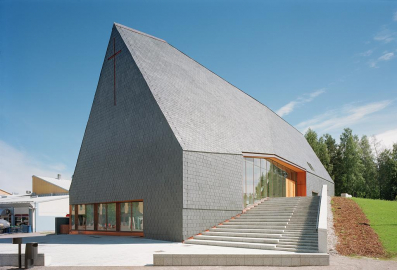
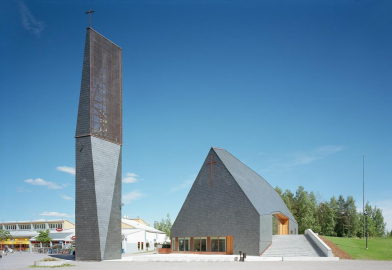
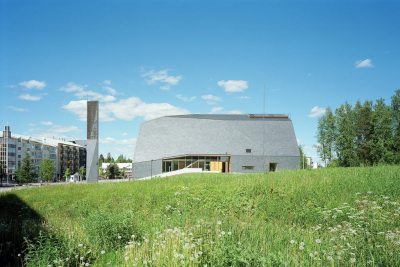
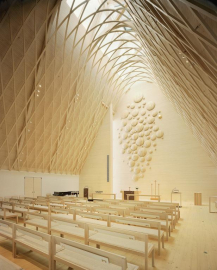
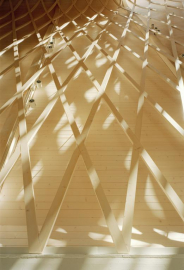
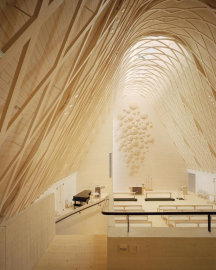
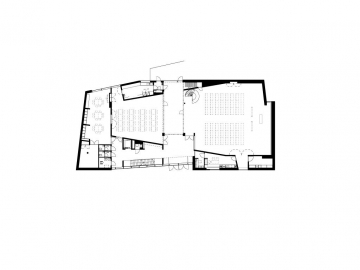
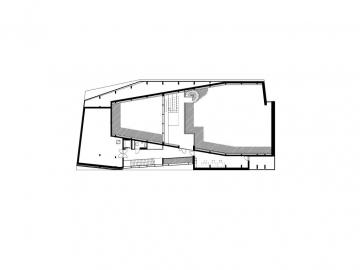
 copy.jpg)
